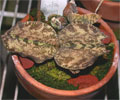|
|
|
|
|
| |
Flasks of
Oeceoclades roseovariegata 'Cryptic' × self |
|
| |
|
|
| |
| Number: |
TN4183 |
| Name: |
Oeceoclades roseovariegata 'Cryptic' × self
|
| Type: |
self (What's that?) |
|
Seed Donor: |
Nicholas Plummer
|
|
Click to Enlarge

Pod Parent Flower |
Click to Enlarge

Pod Parent Plant |
Click to Enlarge

Offspring 'Camouflage' Plant |
| Offspring photos are siblings of the plants you would receive. |
|
|
|
| |
Culture Notes from Donor: Parent plant: Temperature range I (60-83°F). The plant is cultivated in a greenhouse with winter minimum of 60°F and summer maximum of 95°F. Potting mix is 1 part peat, 1 part sand, and 1 part perlite, top-dressed with gravel.
Comments: This species grows in arid habitat in Madagascar. Other plants in habitat include succulent Pachypodium and Euphorbia species.
Parent plant: Small plant. This plant was obtained from Huntington Botanical Gardens as ISI 2001-41/HBG 80665. This plant is a seedling of plants "collected 12/14/93 at Berevo, Madagascar growing in shade of Pachypodium bicolor. Collectors: Roosli and Hoffmann." The cultivar name refers to the mottled appearance of leaves that would camouflage plant.
For additional origin/habitat information supplied courtesy of
Charles and Margaret Baker, see further below, near the bottom of this page.
|
Temperatures we attempt to use in the lab & greenhouse:
| For Species: |
|
Spring, Summer, Autumn: days average 82°F, nights 68°F; best fit is Warm-Intermediate 87-64°F
(Source:
Baker's Web OSC) |
| For Species: |
|
Winter: days average 78°F, nights 63°F; best fit is Intermediate 83-60°F
(Source:
Baker's Web OSC) |
|
About the name...
| Etymology of |
Oeceoclades |
|
From latinized Greek "oikeios" own, private; "klados" twig. Meaning not clear.
(Source:
Mayr & Schmucker 1998) |
| Pronunciation of |
Oeceoclades |
|
ee-see-oh-KLAH-deez
(Source:
Hawkes 1978) |
|
If you would like to direct someone to this web page, please copy and paste this URL into your email:
http://troymeyers.com/d?014183
| Flask Information |
| Availability: |
We have sold all of the flasks for this item. |
| You should: |
Consider getting individual plants or compots instead of a flask.
You can place a "Notify Flask Recipients" Request, and either we or a flask recipient may contact you when plants are available.
You may also place a "Notify Retries" Request, and if an identical pollination (the same parents) is done again, we'll let you know.
You may reserve a flask, but it's very unlikely you'll get one ...this could only happen if we found a flask that we didn't know we had. |
| Yield Estimate: |
475 plants (based on flask surveys done 11/03/2004 through 04/18/2006)
|
| Plantlet Sizes: |
From many flasks 2 - 50 mm plants (based on flask surveys done 10/22/2004 through 04/10/2007)
From one most recently surveyed flask 20 - 40 mm (04/10/2007)
|
|
You might also want to:
|
View the seed assay for this item.
View items of the same species.
View items of the same genus.
|
| Ordering Information |
| You are not currently logged in. |
|
You must be a registered user and be logged in to reserve a flask or place a notification request. Please log in:
|
|
|
|
|
|
| |
The origin/habitat information below is supplied courtesy of Charles and Margaret Baker
The following information is based on the name of the plant provided by the donor, and assumes that the name is correct. If the plant has been misidentified, then the following information may not be correct.
This text is copyrighted by the Bakers and may not be reproduced without permission.
ORIGIN/HABITAT: Northern Madagascar. This terrestrial orchid grows in
mossy cracks in calcareous rocky terrain and semideciduous forest near
Antseranana (formerly Diégo-Suarez). Habitat elevation was not reported,
so the following climate table and cultural suggestions are based on an
estimated elevation and should be used rather cautiously until the actual
habitat elevation is known.
More about this information and the Bakers...
|
|
|
| |
|
|
|